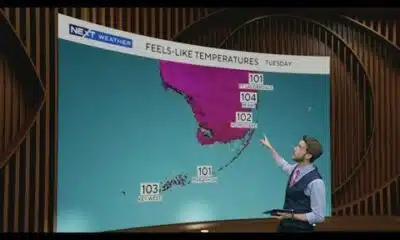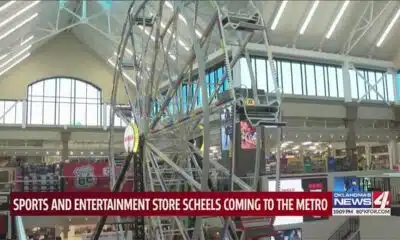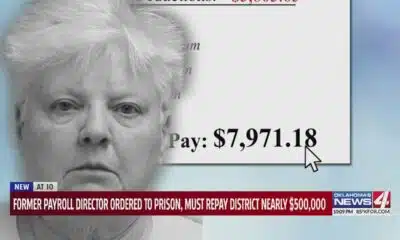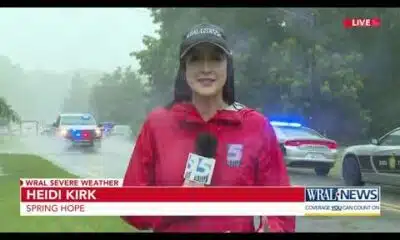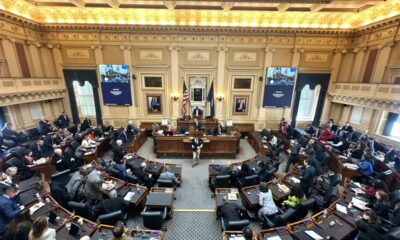News from the South - North Carolina News Feed
Will Asheville Muni get FEMA funding for storm renovations? Bike lanes, sidewalks in rebuilt Swannanoa River Road area? Why is I-26 marked east/west when it runs north/south? • Asheville Watchdog
Today’s round of questions, my smart-aleck replies, and the real answers:
Question: I recently played Asheville Muni and heard some good news about restoration. It sounds like FEMA will pay for restoring the front nine of the golf course that was destroyed in Helene. Is this correct? Is this in exchange for using the front nine as a potential debris storage site? Also, what is the timetable for restoring the front nine? And what’s the estimated cost?
My answer: I’m still a little flabbergasted that Helene managed to take down hundreds of thousands of trees in western North Carolina but left standing the one stupid tree I hit every single time off the tee on number 13. Every time.
Real answer: Let’s not get too far ahead of ourselves. Chris Corl, the city of Asheville’s director of community and regional entertainment facilities, said there’s not “a lot of certainty yet related to the future of the course.”
“We are working towards a restoration of the Muni; however, to be clear, we still have yet to fully identify funding for the project,” Corl said. “It is assumed that FEMA public assistance funding will be available to restore the front nine of the course, however, not yet confirmed.”
The Muni, designed by noted golf course architect Donadl Ross, dates to 1927 and has a rich history. The front nine, parts of which border Swannanoa River Road, sustained heavy damage from Helene, including multiple greens that were destroyed and fairways laden with a heavy deposit of silt.
The city is working with a consulting firm, Hagerty Consulting, “to work through the process, starting with an official damage assessment.” The city did agree to let the front nine be used to store storm debris, but that “does not have anything to do with the restoration project,” Corl said.
“We don’t have a timeline yet for the project and, unfortunately, we don’t have a timeline for the timeline,” Corl said. “Our operator, Commonwealth Golf Partners, has been working on construction estimates for us to understand the potential costs associated.”
The repairs will be extensive — and expensive.
“Depending on the final scope and scale of the project, we’re currently estimating costs between $5 million and $7 million, the bulk of these expenses being full replacement of the irrigation system and repair and replacement of sections of stormwater piping,” Corl said. “For clarity, the new stormwater work completed this past summer was not damaged in the storm.”
The city had just completed a lot of work on the course before Helene hit Sept. 27. Pre-Helene, the city had secured nearly $3 million for repairs and upgrades to the historic course, and it had spent hundreds of thousands of dollars on new bunkers and tee boxes, upgraded greens, and trimming and removing trees.
But not the one that overhangs the 13th fairway.

Question: Since Swannanoa River Road was completely destroyed near the WNC Nature Center and is being rebuilt from scratch, any chance they’re leaving enough room for a sidewalk or bike lane? People used to walk and bike that curve all the time, even at night. The Greenway master plan includes this section, connecting the Nature Center/Rec Pool/Azalea Park with Biltmore Village and the existing Wilma Dykeman Greenway. I live near the VA hospital and have been patiently waiting for that section of the greenway to be completed so I can more safely ride my bike to UNCA.
My answer: I’m pretty sure Tunnel Road to I-240 would be a much faster route, but if you’d prefer not to take your life into your own hands, I understand.
Real answer: The destruction in this area, evident in the photo the reader sent in, is pretty mind-boggling. The NCDOT is on the job, but it’s getting the basics done first.

“The completed repairs — building the road back wide enough for two 11-foot lanes and guardrail — are temporary repairs,” NCDOT spokesperson David Uchiyama said via email. “The permanent repairs will follow in the near future.”
Uchiyama pointed out that Helene is the costliest storm in the history of the North Carolina Department of Transportation.
“The damage in many highway corridors across western North Carolina, requiring restoration of infrastructure within federal reimbursement guidelines, continue to be our primary focus,” Uchiyama said. “Federal Emergency Funds cover most, but not all, of the cost to replace lost infrastructure.”
Improvements such as sidewalks and bike lanes along the roadway the reader asked about remain a possibility further into the future.
“Sidewalks and bike lanes that were not in place before the storm damage are considered ‘betterments,” Uchiyama said. “Local NCDOT engineers are engaged with our federal partners to determine if any types of betterment are eligible for federal assistance, or if alternative funding is available to cover cost of betterments during the reconstruction process.”

Question: In the United States, interstate highways are even-numbered for east-west routes and odd-numbered for north-south routes. On a map, I-26 is way more north-south in its projected route. Why the even number and east-west signage?
My answer: On a map, I-26 always looks uncrowded, too. I’m more concerned about that.
Real answer: This question arises periodically, I suspect, from people who move here and realize this corridor through Asheville really does not run east-west at all. They are not wrong.

I went back to Uchiyama for this one, and he noted that the American Association of State Highway Transportation Officials developed the procedure for numbering interstate routes in the 1950s.
“I-26 began running east-west from Charleston to Columbia in 1960,” Uchiyama said, referring to those cities in South Carolina. “The interstate expanded from there. The path of I-26 — whether created just for the interstate or as other highways expanded and absorbed the identification — then expanded out from Columbia to what we know it as today.”
I-26 used to end in Asheville, but it’s been extended into northern Buncombe as “Future I-26,” then into Madison County with a new section of I-26 built in the early part of this century and through Tennessee, where it eventually meets up with Interstate 81.
In other words, it’s sort of evolved from what was mostly an east-west highway into what it is today.
Uchiyama cited the Federal Highway Administration, which notes, “An occasional inconsistency is inevitable in a complicated, evolving network. They cause little difficulty for the traveling public. Most motorists are not aware of the numbering pattern; when driving in areas with which they are unfamiliar, motorists choose routes based on maps, signs, or directions received along the way.”
Asheville Watchdog is a nonprofit news team producing stories that matter to Asheville and Buncombe County. Got a question? Send it to John Boyle at jboyle@avlwatchdog.org or 828-337-0941. His Answer Man columns appear each Tuesday and Friday. The Watchdog’s reporting is made possible by donations from the community. To show your support for this vital public service go to avlwatchdog.org/support-our-publication/.
Related
The post Will Asheville Muni get FEMA funding for storm renovations? Bike lanes, sidewalks in rebuilt Swannanoa River Road area? Why is I-26 marked east/west when it runs north/south? • Asheville Watchdog appeared first on avlwatchdog.org
News from the South - North Carolina News Feed
In Depth with Dan: Answering viewer questions about flesh-eating bacteria, digital licenses
SUMMARY: In this Monday mailbag, Dan addresses viewer questions on three topics. First, North Carolina’s Vibrio bacteria risk in summer coastal waters: cooked shellfish is safe, but raw consumption is risky due to bacteria concentrating in oysters. Second, digital driver’s licenses in North Carolina face delays; although legalized in 2023, full rollout may not occur until 2026, with other states also lagging behind. Lastly, Dan explains flood-damaged vehicles after recent storms: flooded cars must be branded as such, but scams occur. He shares tips to spot flood damage when buying used cars, emphasizing caution and thorough inspection.
WRAL anchor/reporter Dan Haggerty answered viewer questions about a flesh-eating bacteria in North Carolina and the legalization of digital driver’s licenses.
News from the South - North Carolina News Feed
The latest update on Tropical Storm Erin
SUMMARY: Tropical Storm Erin is forecast to become a Category 1 hurricane by Thursday and remain well out to sea through Saturday, near the Lesser Antilles northeast of Puerto Rico. Models show it moving west, then curving north toward Bermuda or Florida, but uncertainty remains high beyond next week. The American and European models suggest it could pass between Bermuda and Hatteras, causing higher surf midweek. Due to large forecast errors, the storm’s exact path is unclear, ranging from north of New York to the Florida panhandle. Residents should prepare hurricane kits and stay updated, with clearer guidance expected by Thursday or Friday.
Will Erin cause problems for the East Coast? Here’s the latest on Monday evening.
https://abc11.com/post/tracking-tropics-tropical-storm-erin-forms-eastern-tropical-atlantic-cabo-verde-islands/17499988/
Download: https://abc11.com/apps/
Like us on Facebook: https://www.facebook.com/ABC11/
Instagram: https://www.instagram.com/abc11_wtvd/
Threads: https://www.threads.net/@abc11_wtvd
TIKTOK: https://www.tiktok.com/@abc11_eyewitnessnews
X: https://x.com/ABC11_WTVD
News from the South - North Carolina News Feed
Body of missing NC teen found in Florida, family says
SUMMARY: The body of missing North Carolina teen Gio Gio was found in Bradenton, Florida, confirmed by his family. Originally, Gio Gio was supposed to be picked up by relatives after meeting cousins in Florida, but he disappeared after texting his mother for help. His family’s private investigators, not the police, discovered his body near I-75 after police had initially searched the area. Gio Gio’s mother expressed her heartbreak on Facebook, calling it every parent’s worst nightmare. The investigation continues, focusing on the timeline after Gio Gio entered the car with his cousins. An autopsy is pending, with no immediate signs of foul play.
The body of Giovanni Pelletier was found in a retention pond, authorities said, and his mom is living “every parent’s worst nightmare.”
https://abc11.com/post/giovanni-pelletier-body-missing-18-year-old-north-carolina-found-pond-where-last-seen-family-says/17483056/
Download: https://abc11.com/apps/
Like us on Facebook: https://www.facebook.com/ABC11/
Instagram: https://www.instagram.com/abc11_wtvd/
Threads: https://www.threads.net/@abc11_wtvd
TIKTOK: https://www.tiktok.com/@abc11_eyewitnessnews
X: https://x.com/ABC11_WTVD
-
News from the South - Oklahoma News Feed3 days ago
Former payroll director ordered to prison, must repay district nearly $500,000
-
News from the South - North Carolina News Feed6 days ago
Two people unaccounted for in Spring Lake after flash flooding
-
News from the South - Texas News Feed4 days ago
Jim Lovell, Apollo 13 moon mission leader, dies at 97
-
News from the South - Tennessee News Feed5 days ago
Trump’s new tariffs take effect. Here’s how Tennesseans could be impacted
-
News from the South - Missouri News Feed4 days ago
Man accused of running over Kansas City teacher with car before shooting, killing her
-
News from the South - Oklahoma News Feed6 days ago
Tulsa, OKC Resort to Hostile Architecture to Deter Homeless Encampments
-
News from the South - Louisiana News Feed6 days ago
Drugs, stolen vehicles and illegal firearms allegedly found in Slidell home
-
News from the South - Virginia News Feed7 days ago
Virginia House in the balance: 5 key races to watch this fall






